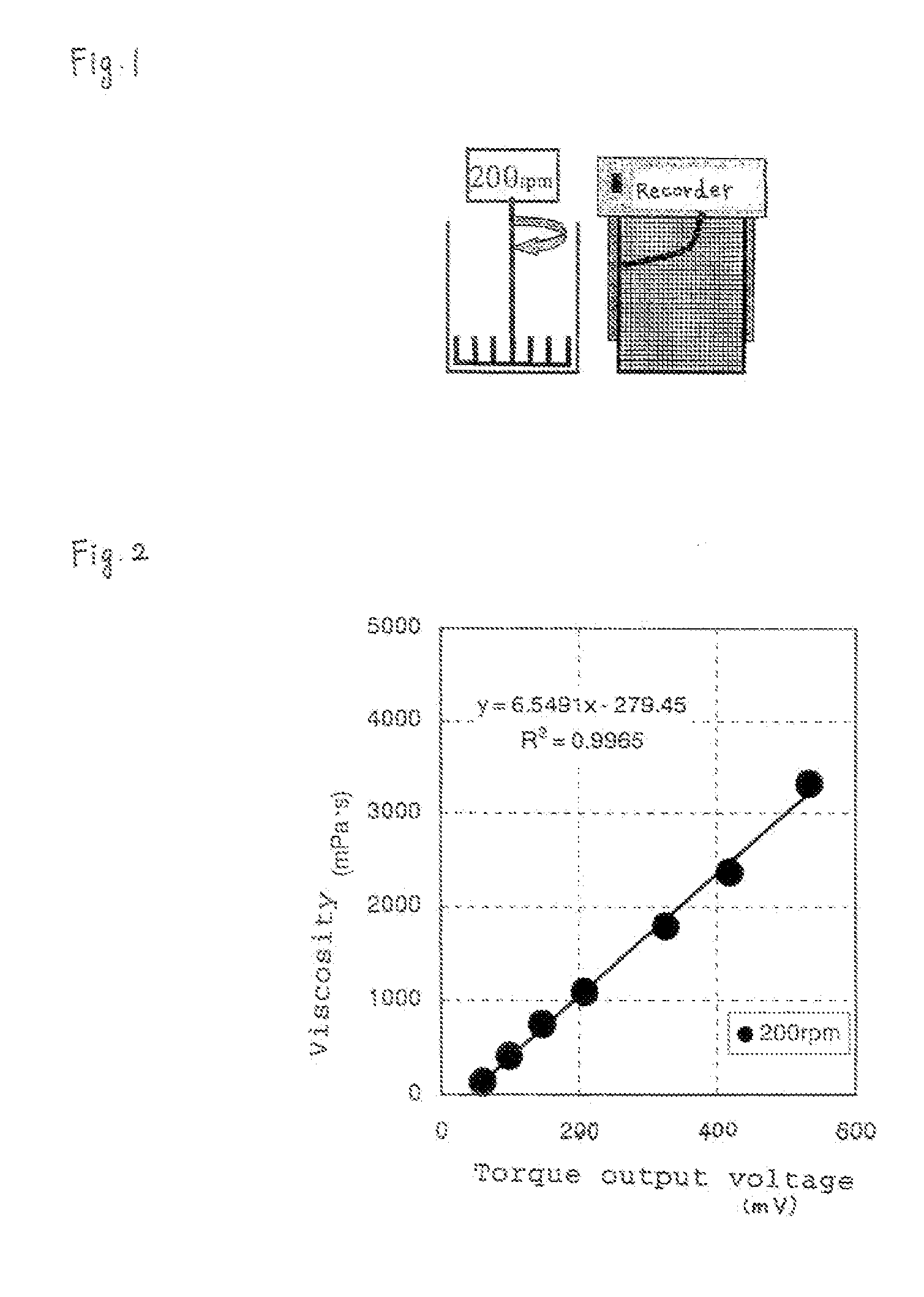Hydraulic composition dispersant
a technology of dispersant and water, applied in the field of water composition dispersant, can solve the problems of unit water amount, inability to work, and inability to stir,
- Summary
- Abstract
- Description
- Claims
- Application Information
AI Technical Summary
Benefits of technology
Problems solved by technology
Method used
Image
Examples
production example 1
of a Polymer B
[0166] A glass reactor (four-neck flask) equipped with a stirrer was charged with 218 g of water, the atmosphere in the reactor was substituted with nitrogen with stirring and the temperature of the water was raised to 80° C. A solution prepared by dissolving 55 g of ω-methoxypolyethylene glycol monomethacrylate (trade name: NK Ester M230F, manufactured by Shin-Nakamura Chemical Co., Ltd., added mole number of ethylene oxide: 23, content of methacrylic acid: 0% by weight), 32.3 g of a mixture (trade name: Phosmer M, manufactured by Unichemical (k.k.) of mono(2-hydroxyethyl)methacrylic acid phosphate ester and di[(2-hydroxyethyl)methacrylic acid] phosphate ester and a solution prepared by dissolving 1.1 g of 3-mercaptopropionic acid in 55 g of water and a solution prepared by dissolving 3.8 g of ammonium persulfate in 43 g of water were respectively added dropwise to the water over 1.5 hours. After the mixture was cured for 1 hour, a solution prepared by dissolving 1.9 ...
production example 2
of a Polymer B
[0167] A glass reactor (four-neck flask) equipped with a stirrer was charged with 471 g of water, the atmosphere in the reactor was substituted with nitrogen with stirring and the temperature of the water was raised to 80° C. A mixture obtained by blending 290 g of ω-methoxypolyethylene glycol monomethacrylate (average added mole number of ethylene oxide: 9) (effective content: 84.4%, water content: 10%, content of methacrylic acid: 0.9% by weight based on ω-methoxypolyethylene glycol monomethacrylate), 93.8 g of a phosphate (a) and 11.3 g of 3-mercaptopropionic acid and a solution prepared by dissolving 8.2 g of ammonium persulfate in 46 g of water were respectively added dropwise to the water over 1.5 hours. After the mixture was cured for 1 hour, a solution prepared by dissolving 3.3 g of ammonium persulfate in 19 g of water was added dropwise to the resulting mixture over 30 minutes, which was then cured at the same temperature (80° C.) for 1.5 hours. After the cur...
production example 3
of a Polymer B
[0169] A glass reactor (four-neck flask) equipped with a stirrer was charged with 180 g of water, 94 g of ω-methoxypolyethylene glycol monomethacrylate (trade name: NK Ester M230G, manufactured by Shin-Nakamura Chemical Co., Ltd., added mole number of ethylene oxide: 23, content of methacrylic acid: 0% by weight) and 8.8 g of sodium methallylsulfonate to dissolve. Then, 32.1 g of a mixture (Ethylene glycol methacrylate phosphate ester (Aldrich reagent) of mono(2-hydroxyethyl)methacrylic acid phosphate and di-[(2-hydroxyethyl)methacrylic acid] phosphate was added and an aqueous 30% sodium hydroxide solution was further added to the mixture. The mixture was adjusted to pH 8.5 by adding a sodium hydroxide solution. After the atmosphere in the reactor was substituted with nitrogen, the temperature of the system was raised to 60° C. in the nitrogen atmosphere. A solution prepared by dissolving 1.8 g of ammonium persulfate in 43.2 g of water was added dropwise to the reactio...
PUM
| Property | Measurement | Unit |
|---|---|---|
| pH | aaaaa | aaaaa |
| weight ratios | aaaaa | aaaaa |
| molar ratio | aaaaa | aaaaa |
Abstract
Description
Claims
Application Information
 Login to View More
Login to View More - R&D
- Intellectual Property
- Life Sciences
- Materials
- Tech Scout
- Unparalleled Data Quality
- Higher Quality Content
- 60% Fewer Hallucinations
Browse by: Latest US Patents, China's latest patents, Technical Efficacy Thesaurus, Application Domain, Technology Topic, Popular Technical Reports.
© 2025 PatSnap. All rights reserved.Legal|Privacy policy|Modern Slavery Act Transparency Statement|Sitemap|About US| Contact US: help@patsnap.com



